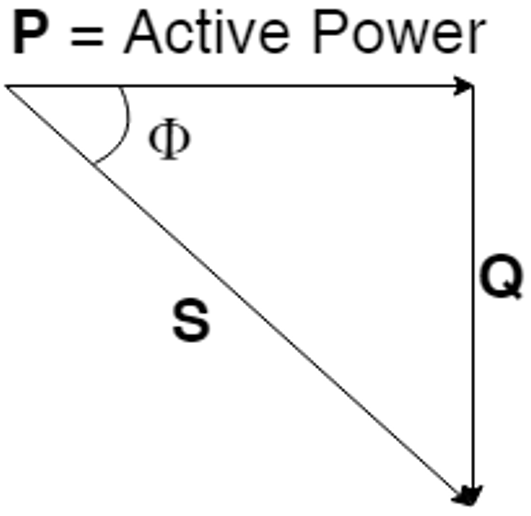This set of FACTS Multiple Choice Questions & Answers (MCQs) focuses on “Compensation Techniques”.
1. In power system, the purpose of reactive power compensation is to ________
a) increase inductive KVAR in power transmission to obtain poor power factor.
b) decrease real power transmission capacity
c) increase real power transmission capacity
d) increase transmission losses
View Answer
Explanation: In power system, one of the purposes of reactive power compensation is to increase real power transmission capacity, improving power factor of the system. Other purposes include decreasing of transmission losses due to excessive current flow, up keeping of a good voltage profile in the power system, etc.
2. In power system, the desired rapid but smooth response in controlling the reactive power compensation is NOT achieved by the traditional methods in conventional AC transmission systems as can be obtained through FACTS because of ________
a) slow response and wear and tear of mechanical components
b) power electronic devices
c) thyristor based controllers
d) fast response of mechanical components
View Answer
Explanation: In power system, the desired rapid but smooth response in controlling the reactive power compensation is NOT achieved by the traditional methods in conventional AC transmission systems as can be obtained through FACTS. This is because of slow response and wear and tear of mechanical components used in the latter one. ʻFACTSʼ employs controllers implemented by power electronic converters which results in smooth, continuous but rapid and repeatable operations of the controllers.
3. What type of triangle this figure indicate?

a) Scalene triangle
b) Isosceles triangle
c) Right angled triangle
d) Acute angled triangle
View Answer
Explanation: The triangle given is known as power triangle. This power triangle is basically a right angled triangle where the component of Reactive Power Q is in right angle with that of Active Power P. Apparent Power S makes the base angle \(\Phi\) with the active power. It is the basic illustration of relation between different types of power encountered during transmission of electric power.
4. What does S represent in the equation S=P+jQ?
a) Apparent power
b) Real power
c) Active power
d) Reactive power
View Answer
Explanation: In the equation S=P+jQ, S represents Complex power or apparent power. P represents the active power or the real power. Q represents the reactive power attributed by the capacitive or inductive component of the system concerned.
5. Match the following.
| FACTS devices | Characteristics |
|---|---|
| 1] STATCOM | A] Combined series-shunt Controller |
| 2] Unified Power Flow Controller | B] Combined series-series Controller |
| 3] Interline Power Flow Controller | C] based on conventional thyristors |
| 4] Static VAR Compensator | D] based on GTO thyristors |
a) 1 – A
b) 2 – B
c) 4 – D
d) 1 – D
View Answer
Explanation: On comparing the characteristics of the given four devices, Unified Power Flow Controller, Interline Power Flow Controller, Static VAR Compensator and STATCOM; we find the following comparison chart with respect to their features.
| FACTS devices | Characteristics |
|---|---|
| 2] Unified Power Flow Controller | A] Combined series-shunt Controller |
| 3] Interline Power Flow Controller | B] Combined series-series Controller |
| 4] Static VAR Compensator | C] based on conventional thyristors |
| 1] STATCOM | D] based on GTO thyristors |
6. SVG is an acronym for ________
a) static VAR Generator
b) sub-synchronous VAR Generator
c) synchronous VAR Generator
d) super-synchronous VAR Generator
View Answer
Explanation: SVG is an acronym for Static VAR Generator. This static device is able to draw controlled capacitive and/or inductive current from an electrical power system connected to it. Therefore, it can generate or absorb reactive power.
7. BESS is the abbreviation of ________
a) battery Energy Storage System
b) bypass Energy Storage System
c) battery Energy Series System
d) battery Energy Shunt System
View Answer
Explanation: BESS is the abbreviation of Battery Energy Storage System. It is basically a chemical based energy storage system. When used with shunt connected VSCs, the system is able to adjust energy to be supplied to or absorbed from a system.
8. SVS is an acronym for ________
a) static VAR System
b) static Voltage System
c) synchronous Voltage System
d) synchronous VAR System
View Answer
Explanation: SVG is an acronym for Static VAR System. It indicates the group of FACTS controllers which are principally VAR compensators. It denotes the arrangement of those static and mechanically-switched VAR compensators whose outputs are coordinated.
9. SSG is an acronym for ________
a) static Synchronous Generator
b) static Sub-synchronous Generator
c) static Super-synchronous Generator
d) static Series Generator
View Answer
Explanation: SSG is an acronym for Static Synchronous Generator. This term can be generalized to indicate the act of connecting any energy source to a device e.g. STATCOM. The energy sources include rectifier/inverter, flywheel, batteries, large dc storage capacitors, etc.
10. What does SMES stand for?
a) Superconducting Magnetic Energy Storage
b) Sub-synchronous Magnetic Energy Storage
c) Super-synchronous Magnetic Energy Storage
d) Synchronous Magnetic Energy Storage
View Answer
Explanation: SMES stand for Superconducting Magnetic Energy Storage. It is based on superconducting electromagnetic aspect. It dynamically controls power flow in an ac system. This device is equipped with electronic converters that rapidly do the action of absorbing and/or injecting power, real or reactive.
Sanfoundry Global Education & Learning Series – Flexible AC Transmission System (FACTS).
To practice all areas of Flexible AC Transmission System (FACTS), here is complete set of 1000+ Multiple Choice Questions and Answers.
If you find a mistake in question / option / answer, kindly take a screenshot and email to [email protected]
